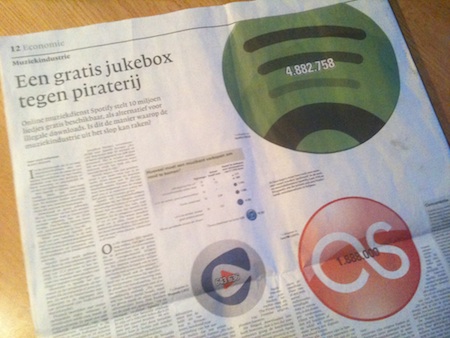NRC writes about piracy, plagiarizes statistics in doing so
Had a bit of a deja-vu this morning when browsing through the economics section of friday’s NRC Handelsblad: Page two of that section contains a full page article (‘free jukeboxes against piracy’) on music streaming services such as spotify.com (click to enlarge, no online version available):

As you can see from the photo above, the article does come with a nifty info-graphic that illustrates how little artists earn from their music being available on services such as spotify (the number 4.882.758 in the green circle indicates how many times a single song needs to be played by users of spotify in order generate an income that is equal to the minimum wage in the Netherlands).
Now there is nothing wrong with this info-graphic as such, but there are two rather dubious aspects: the article is not providing any information with regards to the source of the data used and i had the strong impression that i had seen this info-graphic before (the deja-vu mentioned above).
A quick google query reveals that this was indeed the case: in april 2010 informationisbeautiful.net published a strikingly similar info-graphic (‘How much do music artists learn online?’) that obviously served as the basis for the illustration in the NRC:
The overall numbers are different, but that is simply the result of the fact that the NRC article is using dutch minimum wage (€1.416) as a reference point while the original used the US minimum wage ($1.160). this results in different sales numbers required to generate minimum-wage level income but for the rest the data used to illustrate the NRC article is identical (even worse they simply took the original artists revenue numbers that were expressed in dollars and simply re-stated them in euros).
It is bad enough that the NRC simply lifts these numbers from a website (which itself did took most of the figures from another blog, but makes that very clear by giving credit both to the originating blog and pointing out additional data sources) without giving credit. This is not only plain old-plagiarism (especially dumb if the subject of the article is ‘piracy’) but also grossly misleading: If the NRC article would have given credit to the source readers would have had the opportunity to take a look at the source themselves and would have learned that the figures presented by the NRC are missing an important caveat that is present in the original blogpost on informationisbeautiful.net:
Note: these figures do not include publishing royalties (paid to composers of songs). The full spreadsheet of data does though. You can see all the numbers and sources here: http://bit.ly/DigitalRoyalty
If you click through to the google docs spreadsheet with the full numbers you will see that if you count publishing royalties the amount of plays of a song on spotify required to make minimum wage is reduced by almost 75%. This still means that you need north of 1 million plays (which still is outrageous) but apparently 4.8 million required plays look a bit better when you want to illustrate an article.
This once again shows that the NRC really needs to realize that the days where they were the ‘quality newspaper’ more or less by default are over. Pointing out your sources is one of the key ingredients of credible journalism and unfortunately for the NRC it seems that new media outlets such as informationisbeautiful.net are lightyears ahead of the NRC here…
